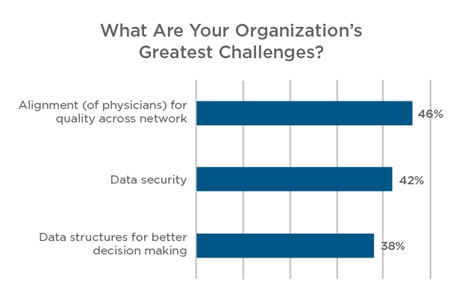In Brief
Research conducted by Huron reveals that data is the top concern for C-level and functional leaders across operations, strategy, technology and clinical care. Leaders understand that getting a grasp on data — how to collect, protect, distribute, analyze and use it for better outcomes — will make or break their success in healthcare.
Making data secure, accessible and understandable in a way that guides strategic decisions is a major opportunity for healthcare leaders. Investments are being made across the industry in automation, artificial intelligence and other tools intended to power a new era of data-driven decision making. Yet, a HIMSS Analytics report finds that only about 25% of organizations are using analytics across their systems.
The problem isn’t lack of data — every organization, especially in healthcare, is inundated with data. The issue isn’t even tools in many cases. There are exceptional data visualization solutions in market that generate slick reports and interactive dashboards. The challenge is whether the data in those reports is valuable and trusted by everyone in the organization.
Too often, organizations adopt technical data solutions before they clearly define their strategy, identify the major issues they are trying to use data to solve, and establish the governance that will be their road map. To advance their strategic use of data, organizations must first focus on these foundational principles that make the broader adoption of data analytics possible.
Governance Is the Foundation for Growth
Using data well across a system is as much an organizational challenge as it is a technical challenge. From data quality to data structures to visualization tools, there are a number of factors organizations need to get right before they can cultivate a data analytics program. However, at the core of everything, is governance.
Leaders should aspire to take data analytics programs to the next level. But without solid governance and management in place, organizations will not get the desired results no matter how sophisticated their new tools may be. Data governance provides the stable foundation required to sidestep potential pitfalls and enable growth in advanced analytics and automated decision-making tools.
While governance is often talked about, it is less common to see it implemented as a core part of an organization’s strategy. When data governance is not intentionally integrated, attempts to manage and utilize data assets fall short because the vision, intended outcomes and key performance indicators or metrics have not been defined.
Planning and managing data then become about implementing the newest version of a technology without a connection to strategy. This gap between purpose and practicality can quickly alienate key stakeholders, such as physicians, whose buy-in is critical for moving an organization along its analytics maturity journey. Leaders should remember it’s never too late to pause to ensure the appropriate strategic foundation is in place before continuing with a data analytics program.
Roles and Responsibilities in Healthcare Data Analytics
Data governance teams should include a diverse mix of ambassadors from information technology (IT), operations, clinicians and other key divisions to represent the needs and challenges of each business unit inside the health system.
Beyond this core team, effective data governance also requires robust executive sponsorship and accountability that follows key leaders all the way through performance evaluations and is included in compensation conversations. Organizations asking individuals to devote a portion of their time outside their direct field of work to build awareness, gain buy-in and administer a data governance plan should plan to incentivize participation.
Governance becomes even more critical as organizations continue to navigate new data assets that accompany mergers and acquisitions, ambulatory expansion and strategic partnerships. Organizations must ensure they have strong executive-level IT leadership that extends into surgical centers, medical group practices, home health and other facilities. Without it, they will struggle to legitimize their data governance plans and fail to establish quality and consistency in both their clinical care and business operations across the enterprise.
Governance Builds Trust in Data
While data governance enables the growth of data as a strategic asset, it should also prevent the use of data in ways that fail to align to the organization’s broader plans. Data governance is essential to stopping the creation of rogue systems and inconsistent reporting methods and performance indicators. Effective data governance, with role definition, clear accountability and embedded review measures, encourages improved collaboration and agile decision making by breaking down silos while discouraging the use of unauthorized data systems.
Another major consequence of poor data governance stems from a lack of trust and transparency wherein stakeholders spend their time questioning available data instead of using it to make informed decisions. Data helps people make thoughtful decisions, but it also often reveals information that people don’t want to accept. When strong governance is established, organizations can more quickly build a source of truth that brings clarity to challenging areas such as individual performance metrics or clinical documentation improvement initiatives. Ultimately, what results is better business operations and safer, more effective care.
KEY TAKEAWAYS
-
Think differently.
Balance the level of investment in new data analytics tools and applications with shoring up foundational elements such as data governance. -
Plan differently.
Ensure there is a clearly articulated strategic vision, along with defined roles and responsibilities, for the use of data analytics enterprisewide. -
Act differently.
Clearly identify the issues that data will solve for your organization and define the metrics that will be used to measure success.


